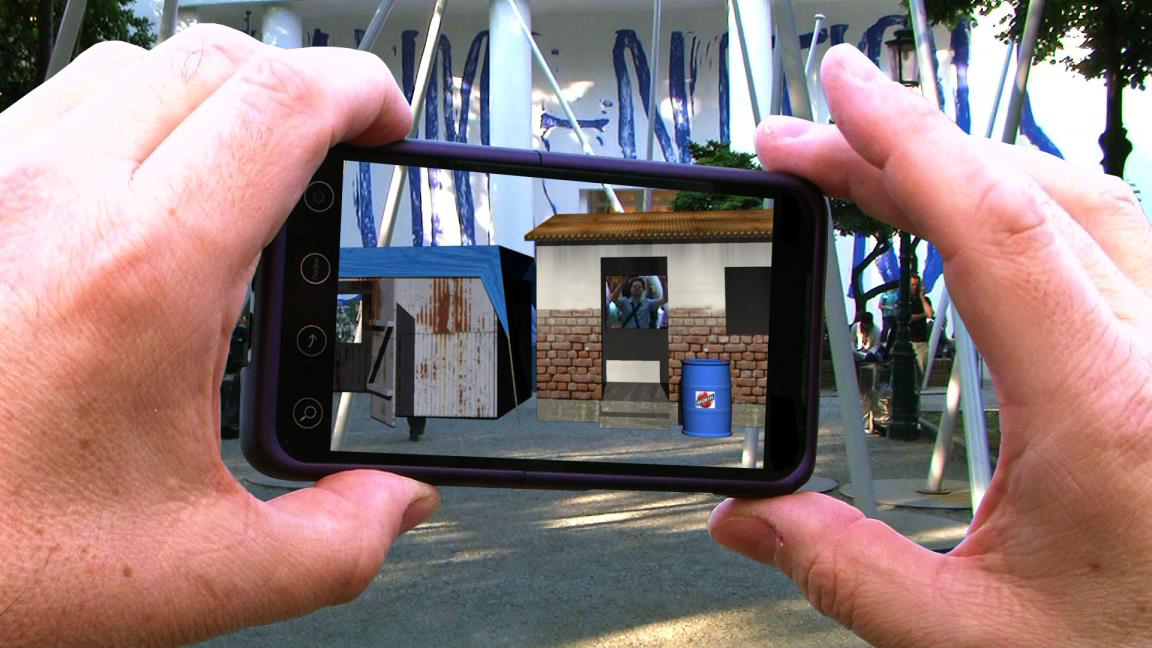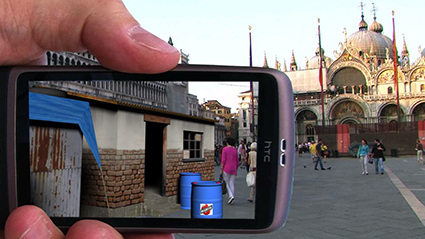December 28, 2013
Augmented Biennale:
The Impact of Digital Technology on the Art and Politics of
the Venice Biennale
Written by Emily Lauren Putnam
Over the past few years, the presence of digital technology has increased at the Venice Biennale. In this paper, I read and compare two different uses of the smartphone at this recognized contemporary art event in order to examine the rising influence of neoliberalism, communication networks, and information technology on the aesthetic and political mappings of the longest running biennale. By juxtaposing the interventionist augmented reality art of Manifest.AR to the iPhone app developed by Christie’s auction house for the 2011 Venice Biennale, this paper explores what happens when the virtual realm is opened up as another site for aesthetic experience. This comparison of an auction house’s marketing tool with the peripheral art of digital interventionists exposes the changing relations between art, politics, and the art market. While the Christie’s app was created as a product associated with the contemporary art market, Manifest.AR’s augmented reality functions as an uninvited intervention that uses the smartphone as a means of critiquing and revealing the ideological structures of the event itself. Utilizing the technology of Google maps, Christie’s app merely simplifies the process of navigating the Biennale, with added insight from experts that can potentially add to the popularity—and market value—of certain artworks. In contrast, Manifest.AR works on the institutional periphery and uses the smartphone as a tool for its guerrilla exhibition strategy. As a result, Manifest.AR introduces a twenty-first century dérive—an alternative mapping of a biennial through the exhibition of a series of unofficial artworks. Even though both Christie’s and Manifest.AR take advantage of the virtual realm, the juxtaposition of these examples reveals the continued expansion and changing nature of art and politics, which can both reinforce the influence of the art market and potentially opens up new sites of resistance within a biennial structure.
I. Digital Guerrillas

Through the presentation of digital images that overlay the physical space of the Venice Biennale, Manifest.AR creates a remapping of the event that invites the attention and movement of spectators away from officially sanctioned works, offering alternative options for aesthetic experience. For this event, John Craig Freeman created Water wARs—the “squatters' pavilion” for undocumented artists and workers found throughout the city. For this piece, Freeman designed a 3D image that looks like a temporary shelter, lacking the grandeur of the permanent Biennale Pavilions. The broken windowpanes and rusted paneling contribute a look of impoverished desperation, though the added clothesline contributes a quality of resourcefulness and necessity. Even though these are just digital renderings, the building looks “lived in,” contrasting with utopian architectural designs that present renderings of buildings in an idealized state, not as signifiers of abject poverty. The blue barrels labeled with the logo of the Bechtel Corporation emphasize the artist’s political motivations. Bechtel is the largest engineering and construction company in the United States. It began as a railroad-grading operation in Oklahoma Territory during the early twentieth century, and since then has grown into a multinational corporation with an expanded range of services. The company website lists some of the corporation’s “signature projects”: Bay Area Rapid Transit, the Hong Kong International Airport, the Hoover Dam, Hurricane Katrina disaster relief, Iraq reconstruction, controlling the Kuwait oil fires, and the Three Mile Island cleanup.[3]This blend of construction projects with disaster cleanup and large-scale industrial renovations illustrates how, with the rise of neoliberalism, private companies are taking a more extensive role in what was formerly relegated to governmental responsibilities, including the distribution (or restriction) of necessary resources, like clean water.
Freeman overlays images of the "squatters' pavilion" throughout the city of Venice, including in the Giardini and Venice’s most famous public square, Piazza San Marco. Water wARs, however, is not limited to the city of Venice. Freeman created this piece with the intention that it would spread around the world. With each iteration, the work's meaning expands in the creation of a digital network that overlays physical place. Like digital versions of graffiti tags, the images of Manifest.AR are both recognizable and modify the topos of public space.


Manifest.AR’s remapping of physical place is part of a longer history of artistic experimentation. In particular, during the 1950s and ’60s, the Situationist International (SI) was actively pursuing the study of “psychogeography,” which is described by Claire Bishop as “the study of the effects of a given environment on the emotions and behavior of individuals.”[4] The dérive, or goal-less drifting, was the primary means of data gathering for the SI. The intent of these urban excursions was to increase one’s awareness of the surrounding environment.[5] According to Bishop, instead of being an end in itself, the dérive was a key means of revealing the material relations and support systems of the urban topos in order to “undo and move beyond what they saw as the disciplining, homogenizing and ultimately dehumanizing effect of modernist forms of urban high-rise living.”[6] The remapping of the Venice Biennale by Manifest.AR is foreshadowed by the SI’s dérive as a means of exposing the hidden structures of social and institutional organization. Their work appropriates the landscape of a physical place while presenting digital montages that overlay the scene in order to create alternative perspectives. This appropriation and intervention both defamiliarizes the scene and introduces tension into the structure of the Biennale.
II. Art World High-Rollers
While Manifest.AR encompasses a rebellious spirit in its interventionist practices, the Christie's app functions as a marketing tool that ends up enforcing hegemonic relations of the transnational art market. The app designed by the Christie's auction house helps users navigate the Giardini and Arsenale—the primary exhibition areas of the Venice Biennale—as well as locating pavilions throughout the city. When opened, the app resembles the Google Maps interface upon which it is based. On this map there are icons of various national flags that are used to demarcate pavilions. When the flag is clicked, the user is provided with a brief description of the pavilion, directions, and options to save and share the link through e-mail, Twitter, or Facebook. The app also offers locations for places to sleep and eat as well as an “Expert Tip” page that provides “insights and tips from Christie’s experts and guests on what to see and do during this year’s Venice Biennale.” Christie’s along with Sotheby’s controls 98 percent of the world auction market for art. As Christie’s is so financially invested in the contemporary art market, it is no surprise that they would become involved in the Venice Biennale, as this happens to be a prominent site for ramping up the reputations of artists. Moreover, the Christie’s Venice Biennale app functions as a tool designed to support the art market through the exposure it provides.
Since the nineteenth century, with the introduction of connoisseurship as a profession, aesthetic judgment and valuation increasingly has been informed by its financial value on the art market.[7] Iain Robertson describes how art can be viewed as a luxury commodity:
[…] an “experience good” that has to be tested or consumed before its true quality is revealed. It is also treated as an “information good,” since so much value is tied to the idea. The acquisition of art, a tangible “consumption good” with “social capital,” is also seen as a positive addiction; the more it is consumed, the more it is desired.[8]
Robertson notes how art is made mainly of “cheap raw materials and presented and sold in both the private and public sectors by an underpaid workforce. It enjoys, in short, through the market’s alchemy, extremely high levels of added value.”[9] What can be attributed to this added value is not always clear. Robertson vaguely describes how the “upward and downward shifts in the value of commodities are determined […] by the commercial and public institutions represented by players working for these institutions.”[10] These changes occur gradually and not always uniformly. Robertson outlines a number of factors that play into a work’s value, including the reputation of the artist, where the work was created, cultural tastes, exhibition record, and more.
Just as various participants—including the artist, curator, audience, critics, and scholars—contribute to the aesthetic and conceptual meaning of an artwork, numerous stakeholders invest in the financial value of a piece. Derrick Chong points out how “players in the contemporary art market, operating as dealers, critics or curators, have significant roles as intermediaries; moreover, institutions displaying contemporary art also influence taste among non-specialist audiences.”[11] Chong describes how there are networks of cooperation in place, involving a complex set of relations that help refine and influence market taste.[12] Large-scale international art fairs, including the Venice Biennale, participate in these relations, as they provide high visibility for artists.[13] Visibility can be considered a significant motivation in Christie’s creation of a Biennale app, since the purpose of this app is to ease navigation of the Biennale and the city of Venice, while also emphasizing certain works over others as “must see” attractions or highlights.
By facilitating navigation of the event, planting highlights in the mind of the spectator, and providing information to assist in the process of interpretation, the Christie’s app helps foster the increased consumption of art, which it directly and indirectly profits from. Even if the users of the app do not have the intentions—or the means—of purchasing work by Biennale artists, spectators are still vital to the consumption of art, as exposure and recognition by a wide audience can influence the prices of works on the auction block.
III. The Influence of Digital Technology on Navigation
Increased reliance on digital tools impacts how a person relates to place, resulting in what I refer to as navigational fetishism. Glimpses of these effects can be detected in instances when a person blindly follows a GPS, ending up in a destination with very little understanding of the physical path she has taken and no clue as to how to retrace her steps. I use the phrase “navigational fetishism” as a means of referencing Karl Marx’s concept of commodity fetishism, which he describes in Capital: Volume 1. Marx defines commodity fetish as the alienation of the consumer from the labor used to create a product as a result of capitalist circulation:“[...] the definite social relations between men themselves which assumes here, for them, the fantastic form of a relation between things.”[14] Capital alienates the consumer from the labor involved in the production of the commodity, resulting in an alienation of consumers from producers. Objects come to replace relations between people with relations between commodities. In the 1960s, Guy Debord incorporated this definition into his description of the spectacle, arguing that not only objects, but also images have come to replace relations between people. Debord describes how the alienating effects of the spectacle result in an acting subject whose “own gestures are no longer his own, but rather those of someone else who represents them to him. The spectator feels at home nowhere, for the spectacle is everywhere.”[15] In terms of navigation, instead of becoming familiar with the terrain that a map represents by interacting with the scene, a person can become wholly reliant on a technological device, the GPS, to do the navigating for her. She can reach her destination without acknowledging the relationship of a map to her terrain, as the device does this task. This process results in alienation of the person in relation to place.
When it comes to understanding the role of technology in both the Christie’s app and the work of Manifest.AR, it is not the manufacturing of the technology that reinforces or challenges ideological structures, but how it is put to use and what is revealed through this use. In “The Question Concerning Technology,” Martin Heidegger explores humanity’s relationship to the essence of technology. He argues that technology is “a mode of revealing. Technology comes to presence in the realm where revealing and unconcealment take place, where alethia, truth, happens.”[16] He describes the essence of technology as Gestell, or enframing:
Enframing means the gathering together of the setting-upon that sets upon man, i.e., challenges him forth, to reveal the actual, in the mode of ordering, as standing-reserve. Enframing means the way of revealing that holds sway in the essence of modern technology and that is itself nothing technological.[17]
Heidegger is more interested in examining the essence of technology as opposed to limiting his discussion to its mechanics. According to Gregory Ulmer, “From Heidegger’s point of view, the danger of technology is that its rigid cause-and-effect enframing order might blind humanity to alternative orders. It is not the technology itself, but this blindness to its enframing, that must be confronted.”[18] Enframing and navigational fetishism plays a role both in the Christie’s app and the work of Manifest.AR, but it is how this enframing relates to the user of the technology that comprises the significant differences between the two. In terms of the Christie’s app, technology is used to reaffirm the material relations of institutional support systems and the art market by alienating the user within a prescribed construct. In contrast, Manifest.AR attempts to expose and subvert these systems while dismantling the alienation effect of navigational fetishism by inviting alternative relationships between the spectator and place.
While the virtual realm offers a site for potential resistance, as seen in the activities of Manifest.AR, it can also reaffirm the institutional power structures already in place, as is the case with the Christie’s app. The digital mappings presented by Christie's and Manifest.AR complement physical place, as they are experienced onsite and unfold in terms of time and space. Juxtaposing the uses of digital technology by Manifest.AR and Christie's exposes how the technology is not inherently responsible for its outcome; rather, how it is utilized and distributed that determine its relationship to the institutional infrastructure of the Venice Biennale.
Emily Lauren Putnam is Head of Creative Media Production/ Lecturer at Shelbourne College, Dublin, Ireland.
[1] Interventionist art is defined as art that is unauthorized by the institutional context of its display. For more information about Manifest.AR and how the group explains their practice, see “About Manifest.AR,” Manifest.AR, accessed October 17, 2012, http://manifestarblog.wordpress.com/about/.
[2] John Craig Freeman, e-mail message to the author, October 7, 2012.
[3] “Corporate Overview,” Bechtel Corporation, accessed March 7, 2013, http://www.bechtel.com/overview.html.
[4] Claire Bishop, Artificial Hells: Participatory Art and the Politics of Spectatorship (London and New York: Verso, 2012), Kindle edition., location 1631.
[5] Ibid., locations 1634–35.
[6] Ibid., locations 1634–35.
[7] Ibid., 2–3.
[8] Iain Robertson, "Introduction: The Economics of Taste," in Understanding International Art Markets and Management, ed. Iain Robertson (London and New York: Routledge, 2005), 3.
[9] Iain Robertson, "The International Art Market," in Robertson, Understanding International Art Markets and Management, 22.
[10] Ibid.
[11] Derrick Chong, "Stakeholder Relationships in Contemporary Art," in Robertson, Understanding International Art Markets and Management, 91.
[12] Chong, "Stakeholder Relationships in Contemporary Art," 84 and 86.
[13] Ibid., 86.
[14] Karl Marx, Capital: A Critique of Political Economy, Volume 1, trans. Ben Fowkes (London: Penguin Books, 1990), 165.
[15] Guy Debord, The Society of the Spectacle (New York: Zone Books, 1995), 23.
[16] Martin Heidegger, "The Question Concerning Technology," in Basic Writings (London: Harper Perennial Modern Thought, 2008), 319.
[17] Ibid., 325.
[18] Gregory Ulmer, Applied Grammatology: Post(e)-Pedagogy from Jacques Derrida to Joseph Beuys (Baltimore and London: The John Hopkins University Press, 1985), 15.









